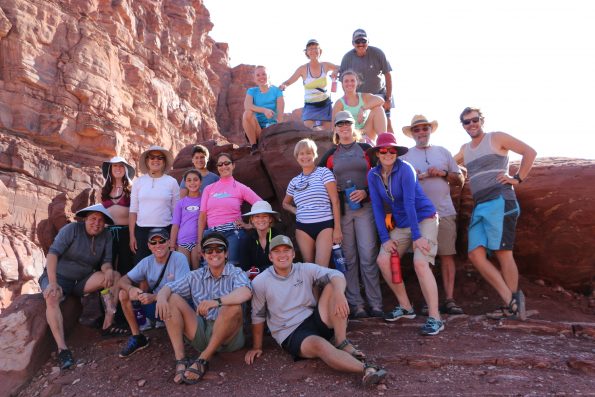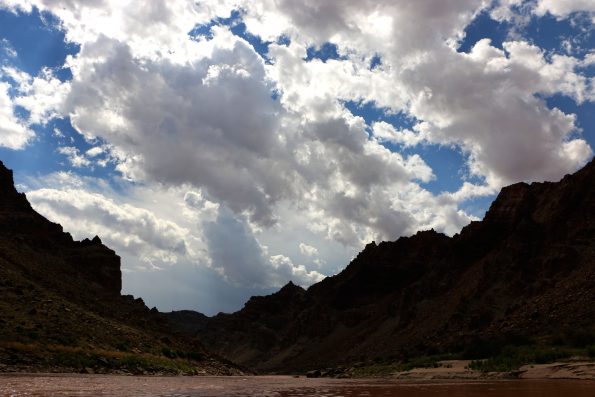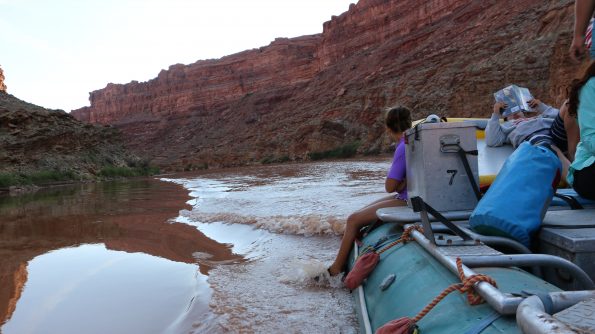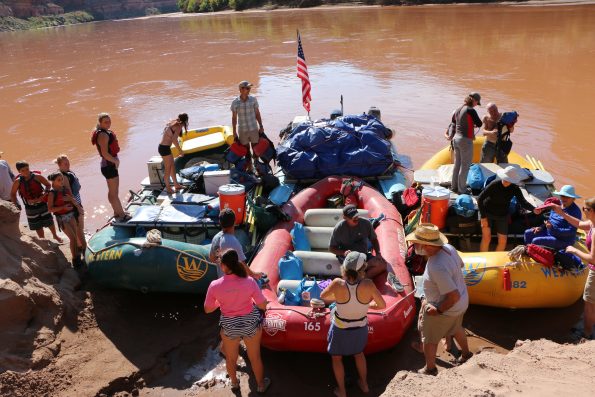
“What’s the difference between a mutual fund and a river guide?” asks Aaron Rappleye as we swap jokes at camp on the river. “A mutual fund matures in four years and starts paying out.”
There are plenty of applicants with delayed maturity, or Peter Pan syndrome, who would gladly love to become a river guide on the Colorado River in Moab, Utah.
The job is seasonal and it certainly involves hard work, including hauling up to three tons of equipment, food and supplies for as many as 40 people on a 4-day rafting trip. But the job offers more than a recurring fix for an adrenaline addiction.
Six months of work provides enough money to live the other six months of the year. Lodging is just $75 in bunk houses for the season and plenty of food is provided on each trip. “We have very few expenses while we are working which allows us to travel during the off-season,” says third-year river guide Brian Essig, who graduated last year from the University of Utah with a degree in Parks, Recreation and Tourism. Brian visited Nepal last winter, toured Asia for three months, and enjoyed about 60 ski days last winter.

We (18 of us in all) are on a four-day excursion down Cataract Canyon, which was nicknamed “Cemetery of the Colorado” by John Wesley Powell. Our guides are four men from the ages of 24 to 26. “I think I’ll be doing this just one more year,” says Aaron, “but that’s what I was saying last year. It’s a hard job to give up.” Aaron adds that guides usually get their positions not by just applying, but through connections. Aaron was hired because his father was a guide for two years not long after Western Rivers began their trips about 25 years ago. “He started as a swamp man, and the second year he was captain of a J-Rig down Cataract Canyon,” says Aaron.
 River Guide Requirements
River Guide Requirements
Today the process to get trained and equipped to become a guide isn’t easy. Men and women seeking their river Captain’s license must run nine rivers. Only after doing the same routes many times, learning how to “read the rapids, scout, navigate, shout commands, learn rescue and safety operations and EMT procedures, do guides get a position on Moab’s daily runs. By the second or third year they might get a position on West Water or Cataract Canyon.
The ominous whirling pools and ferocity of the Cataract rapids have flipped dozens of boats over the years. At high water, 50,000 CFS (cubic feet per second—one cubic foot is around four gallons, amounts to 100,000 gallons rushing through one cubic foot every second), it’s not uncommon to encounter 30-foot waves which rise like buildings—their constant rise and curl, rise and curl—waiting to devour the next victim who dares to enter. To defeat these monsters, Western Rivers Expeditions Moab Adventure Center uses a 40′ boat called a “J-Rig.” It has five pontoons and a 40-horsepower engine to muscle over the beast’s head.
In August the river drops to 6,000 CFS and employs a different tactic: deception. Whirlpools and eddies, appearing harmless, and smaller waves attempt to catch those who aren’t careful into their snare. “If you fall into this pool right here, it will suck you in and spit you out 100 feet down the river,” says guide Taylor Wofford.
I’ve had two groups of friends visit the Cataract (which means a descent of water over a steep surface), and one group flipped, finding themselves struggling to hang onto their overturned boats while attempting to keep their heads above whitewater long enough to find stillwater and beaches to regroup before heaving the boats back over.
This is impossible with a 40′ J-Rig. If a boat that size flips with several tons of equipment attached, a semi truck is required to flip it back over once it reaches Lake Powell. “If we have a flip, the trip is over. We get everyone out and we are done,” said Taylor. Flipping boats almost never happens because the guides are meticulous about scouting rapids.
A Deadly River Now Family Friendly
I’m amazed to find that the majority of our group are people over fifty. Out of 18 people, three couples are in their sixties. One man, Mike, is in his seventies. And two children, Steven and Samantha, are 12 and 11. I think to myself, “I’ve done some crazy rafting, but this river scares me, and there are kids and old people running this. Wow!”
The first recorded river trip in Utah was not the Powell expedition, but a group led by a man named William Henry Ashley, who hired brave men to explore “unknown regions of harsh wilderness” with him. The men who answered the call included Jedediah Smith, Jim Bridger and Jim Beckwourth. These men marched west and into the history books.
When Powell and his men were portaging their equipment across one of the most ferocious rapids on the Green River, they came across an inscription: “Ashley 1825”. It wasn’t verified until 1909 that this excursion took place. Their boats were made from willow branches and buckskin, 16’ long, 7’ wide. After their boats had flipped and their food ran out, Ashley, Beckwourth, and two others were about to draw straws to determine who would sacrifice his body to nourish the others. They decided to carry on for one more day when they came across a party of trappers and were saved from cannibalism. This story recounted by Beckwourth, was a yarn spun in typical mountain-man fashion—lies were encouraged, the only sin was that of being dull.
Today, Samantha (11) answers the question on the first day, “Are you scared?” with, “I’m terrified!” Stephen (12) says he’s not scared and declares he will sleep outside for the first time in his life. The Seligsohn family (father Mark and mother Jennifer) from Margate, New Jersey, are camping on this trip for the first time.
 Like a right-of-passage, Stephen is just a week away from turning 13. They are no strangers to water. The kids play on the beach daily and both are dark bronze. “I skateboard, play sports, mostly football.” Stephen got to decide the destination between Hawaii, Fiji, Costa Rica and White Water Rafting on the the Colorado. His father Mark said, “This is what he wanted to do, so here we are!”
Like a right-of-passage, Stephen is just a week away from turning 13. They are no strangers to water. The kids play on the beach daily and both are dark bronze. “I skateboard, play sports, mostly football.” Stephen got to decide the destination between Hawaii, Fiji, Costa Rica and White Water Rafting on the the Colorado. His father Mark said, “This is what he wanted to do, so here we are!”
On the first afternoon, after launching from Potash Road just 11 miles outside Moab, the clouds show ominous signs. It’s cold and passengers are bundled accordingly. Our four boats are tied together into a massive flotilla. After four hours of being pushed by a 30-horsepower pontoon boat Captained by Taylor Wofford, from Kansas City, Kansas, we begin to set up camp. Then we watch as the water turns from light tan to milk chocolate. “There must be flash-flooded canyons emptying into the river,” says Taylor. There is no rain. “There could be rain 50 miles from here and it would still drain into here.”
“Look dad! I’m Augustus Gloop!” says Stephen, who takes a swim the next morning. The remainder of the trip is spent floating in Charlie and the Chocolate Factory’s chocolate river.
The next morning, after a hike through the hills overlooking the river, we proceed with a “family meeting,” going over what we are about to encounter. “There are some really big holes coming up and we need you all to obey the instruction we are about to give you. I need your absolute undivided attention,” says Taylor. We receive a safety crash course and we are to have our life jackets on at all times, “uncomfortably tight.” We are to remain inside the boat at all times. “You can’t ‘accidentally fall out,’” Taylor says, while making quote marks with his fingers. Then he adds, “That’s not allowed.”
The Boats to Navigate the River in August
We have with us two row boats and one paddle boat. The row boats are completely controlled by the Captain, and passengers get a nice comfortable ride with very little risk due to the navigational prowess of our leaders. But a far superior experience is offered in the paddle boats. Passengers are ordered to paddle to the count of four, “Left forward, Right back!” Navigational commands are shouted by the boat’s Captain, because with a lighter-weight vessel, entire waves will crash over the boat and its passengers. Complete safety is only ensured if everyone is obeying commands. This boat is only used in the fall season with lower waters.
George Kakaty from Saddle River, New Jersey, fell out when we hit a rapid just a bit off center. When a man is overboard, he is to grab the boat’s bow rope and hang on. Fellow passengers grab his life vest and heave him up back onboard. Brooke and myself did this after we failed to paddle fast enough into a class-three rapid. The boat was heaved to the side and dumped George in less than a half second. “There was nothing I could do,” George said.
The rapid was so tall and such a thrill, I realized that I had stopped paddling. I was gazing in awe at the massive power of the wave we were ascending. George’s dump into the water was my own fault for lack of providing forward momentum.
We were instructed that it wasn’t going to happen again. The next day saw rapids with simple names, “Big Drop One, Big Drops Two and Three.” We had a total of 21 rapids to encounter.
In the “Big Drop” series, the canyon descends more than three hundred feet in less than a quarter mile, and in doing so, the water speeds up as gravity, gradient and a narrow chute all culminate to produce a serpentine trip down the back of an angry three-headed beast.
At Big Drop One we are ordered to “relax” as we enter into the calm before the ferocity. We are poised to paddle, big waves coming, closer… closer… until we want to attack. “Relax!” Brian repeats. Then just as we enter into the first wave, “Paddle!” “One… Two… Three… Four!” We need to yell to maintain our rhythm over the incredibly loud water. “One… Two… Three… Four!”
We ascend up and over the first wave as waters enter the boat, trying to pull away anyone it can. We descend down the wave and my paddle fails to find water, only space and air. The voices are more faint. As the space around my face condenses, time seems to slow down.
Then I can hear again the others, “One… Two… Three… Four!” I get my paddle into the water just as the wave attempts to tip our boat sideways. Another ferocious pounding of water pounces on our deck. For nearly two seconds, just water… more water… then the obvious question, “when do we get to breathe?” Then brightness again. I can see! “Whooo hooo!”
Everyone is cheering and shouting for joy. Big Drop One—which has probably claimed dozens of lives, broken hundreds of oars and roars louder than any beast I’ve encountered—and one of the largest rapids in North America, is now behind us. It’s pure joy to realize that nine of us have just survived running a gauntlet, and Cataract nicknamed “the cemetery of the Colorado River” will claim no lives today.
While the adrenaline-packed, water-soaked days made the trip thrilling, the best part of the trip were the people who came. The bonds we shared with our fellow passengers and hearing the truncated stories of their lives was the greatest treat of all.
Keith and Anita Haber have resided in New York since the early eighties. John Belushi bought a building on their street and lived there just two weeks before he died of an overdose. They have been married over forty years. They took their boys on a rafting trip 15 years ago and pledged to one day return to the area.
Christie Schantz lives in San Francisco. She has been pestering her mother for the last ten years to go white water rafting in the Grand Canyon. “I think if I didn’t do it this year she would have gone without me,” said her mother Carol. They were joined by friends Julie Christman and Karen Albertson, who, at age 71, had a smile on her face the entire time.
I was treated to the life stories of Michael Ligrono and Rachelle Meenach-Ligrano. Michael worked at Mountain Safety Research as one of the first employees, along with founder Larry Penberthy. With a mission to manufacture and promote safer climbing equipment, they helped vastly improve the design of climbing ropes and carabiners (some of which were being knowingly sold as faulty by REI, and had to be discarded).
Michael invented the MSR “Whisper Light” stove which can burn nearly any fuel. Their daughter is touring seven national parks in three months of travel. Rachelle’s laugh and constantly happy demeanor was inspiring to see. “I don’t see how anybody can’t enjoy retirement if they go out and do things like this,” said Michael.
George and his wife Joanne live in Saddle River, New Jersey. George has made million dollar deals selling fine china from Bernardaud to fine dining establishments including fancy hotels owned by Donald Trump. He leads a team of sales executives in a multi-national operation, but he and his wife are working to help Syrian Refugees from Aleppo, where his father immigrated to the United States. His father founded the Syrian community in New Jersey and aided in bringing dozens of immigrants to the United States, both Christian and Muslim. His father and my great-grand parents have similar origins, and my interest in my own roots and our common abundance of back hair made it a natural connection.
Witnessing the smiles of the Selingsohn family with their children, I realize that kids and parents alike will remember this trip for the rest of their lives. Not every family with pre-teen kids could endure a trip like this with so few arguments and so many smiles. “We always play games together after dinner. I love playing games with my kids,” said father Mark.
What was the best part of the trip?” I ask Stephen. “Bathing in the river with my dad,” he responded. Despite the chocolate color of the water, they got right in and cleaned up for our final dinner, presented by our squeaky clean guides wearing white shirts and ties. Togas were required for the dinner of steak and shrimp.
After dinner Mark told jokes that split sides, causing rafters to curl over while spewing bits of steak into the air. Especially Keith, whose beet-red complexion from laughing so hard made me fear he might require a helivac evacuation. Teaven-Jai Fredericks (20) and Guide Ben Knight (24) were the winners of Octopus Eight, a group party game that requires quick thinking and fast action.
And finally, a shout-out to Brooke Schultz, 19, and Teaven-Jai Fredericks, 20, both from Moab. Brooke was able to go on the trip for a discount thanks to her job arranging Jeep rentals. Lindsay Mortensen also from Moab, came along with me representing Utah Stories, to take care of essentials such as GoPro powering. Last but not least, a big thanks to Steven for lending me his GoPro after mine went swimming. Be sure to check out our footage from this trip, including our Big Drops into rapids and some time lapse footage, recorded on the GoPro and my Canon 70D.






